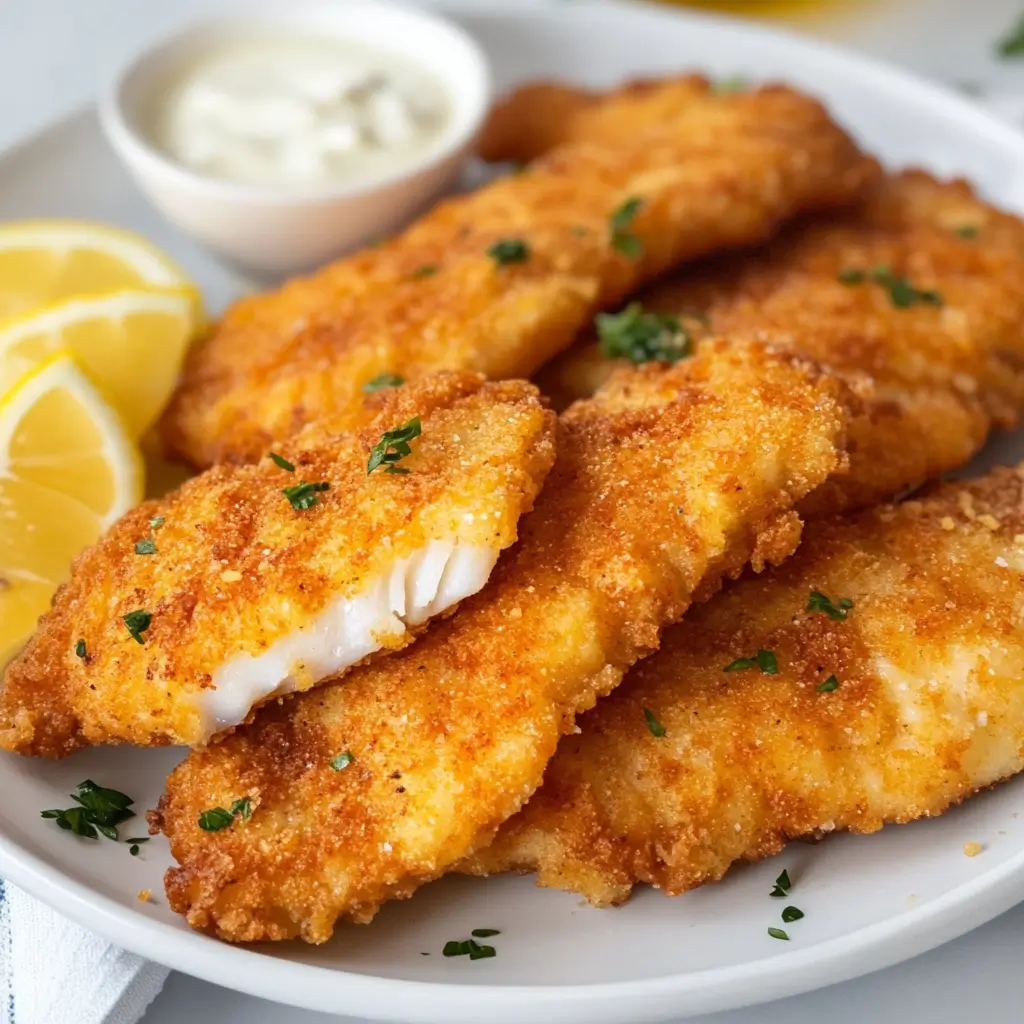Introduction to Fried Flounder
Few dishes capture the comfort and nostalgia of Southern cooking like crispy fried flounder. With its mild flavor and delicate flake, flounder shines when coated in golden cornmeal and sizzled to crunchy perfection. Whether you’re hosting a fish fry or seeking a quick weeknight meal, this recipe offers timeless appeal.
Why Flounder is Perfect for Frying
Flounder is a flat, saltwater fish with a lean texture and sweet, subtle flavor. Its thin fillets cook quickly, making it ideal for frying. Unlike denser fish, flounder crisps up beautifully without becoming dry or rubbery. When fried correctly, the result is flaky inside with a shatteringly crisp crust.
Essential Ingredients for Crispy Perfection
You’ll need:
- 4 flounder fillets (4–6 oz each, skinless)
- 1 cup buttermilk
- 1 cup cornmeal
- ½ cup all-purpose flour
- 1 tsp garlic powder
- 1 tsp paprika
- ½ tsp cayenne pepper (optional)
- Salt & black pepper (to taste)
- Vegetable oil (for frying)
- Lemon wedges and tartar sauce (for serving)
These ingredients create a crunchy, flavorful coating that complements the tender flounder without overwhelming it.
The Buttermilk Bath: Tenderizing and Flavor Boosting
Soaking fish in buttermilk isn’t just tradition—it serves purpose. The buttermilk’s mild acidity tenderizes the protein and enhances flavor. Submerge the flounder fillets in buttermilk for at least 15–30 minutes. This process also helps the dry coating adhere more effectively.
Seasoned Coating: Building Layers of Flavor
For that irresistible crust, combine the dry ingredients in a wide bowl:
- Cornmeal adds crunch.
- Flour provides structure.
- Garlic powder and paprika introduce savory warmth.
- A touch of cayenne gives optional heat.
Balance is key—enough seasoning to enhance, not mask, the flounder’s natural sweetness.
Mastering the Frying Process
Step-by-step:
- Remove the flounder from the buttermilk, allowing the excess to drip off.
- Dredge each fillet in the seasoned cornmeal mixture, pressing gently to coat evenly.
- Let the coated fillets rest for 5–10 minutes to help the crust “set.”
Heat ½ inch of vegetable oil in a skillet to 350°F (175°C). Use a thermometer or test with a pinch of coating—it should sizzle immediately.
Carefully place the fish in the oil, cooking 3–4 minutes per side until golden and crispy. Avoid overcrowding the pan, which lowers oil temperature and results in soggy coating.
Drain, Rest, and Serve: The Final Touches
Once fried, transfer fillets to a paper towel-lined plate to drain excess oil. Serve immediately for best texture.
Garnishes:
- Lemon wedges: for brightness.
- Tartar sauce or hot sauce: classic and complementary.
Delicious Side Pairings
A perfectly fried flounder deserves equally delicious sides. Try:
- Creamy coleslaw
- Buttery hush puppies
- Southern-style green beans
- Crispy French fries
Or opt for a fresh salad if you’re keeping things light.
Tips for Achieving the Perfect Fry
- Use fresh flounder for best flavor and flakiness. If using frozen, thaw and dry thoroughly.
- Double dredge for extra crunch—flour > buttermilk > cornmeal.
- Don’t flip too early—wait until the edges are deep golden.
- Use a thermometer to keep oil at a consistent temperature.
Storage and Reheating Instructions
Fried fish is best fresh, but leftovers can be stored:
- Refrigerator: Up to 2 days in an airtight container.
- To reheat: Place in a 375°F oven for 8–10 minutes to restore crispness. Avoid microwaving—it softens the crust.
Nutritional Information
Per serving (1 fillet):
- Calories: ~320 kcal
- Protein: ~24g
- Carbs: ~18g
- Fat: ~18g
- Sodium: ~450mg (varies by salt content and sauces)
Final Thoughts
This crispy fried flounder recipe brings the spirit of a Southern fish fry straight to your table. It’s flavorful, fast, and fuss-free. Whether paired with traditional sides or a simple salad, it offers hearty satisfaction and soul-warming comfort.


